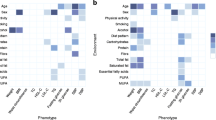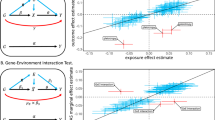Abstract
The importance of environment and genetics working together to shape an individual's risk for atherosclerosis seems intuitively obvious. However, it is only recently that research strategies have begun to evolve that attempt to answer questions related to apportionment of risk that is due to specific environmental and genetic factors. These factors may impact upon risk either singly or, more likely, through a complex interaction that affects the metabolic history of the whole organism. Because the genetic bases of lipid and lipoprotein metabolism have been well-studied, and because of the epidemiologic and pathobiochemical associations between genetic disorders of lipid metabolism and atherosclerosis, researchers have searched for gene-environment interactions within animal and human systems in which the phenotype is defined by some index of lipoprotein metabolism. From work done in the lipoprotein area to this point a clear case can be made for: 1) the genetic influence over the phenotypic response to an environmental stimulus; 2) the environmental modulation of the phenotypic expression of severe genetic defects. In the realm of gene-environment interactions that affect lipoprotein phenotype, diet is the best-studied environmental factor.
Similar content being viewed by others
References
Hopkins PN, Williams RR: A survey of 246 suggested coronary risk factors. Atherosclerosis 40: 1–16, 1981
Kannel WB, Castelli WP, Gordon T, McNamara PM: Serum cholesterol, lipoproteins and the risk of coronary heart disease. The Framingham study. Ann Int Med 74: 1–9, 1971
Kannel WB, Castelli WP, Gordon T: Cholesterol in the prediction of atherosclerotic disease. New perspective based on the Framingham study. Ann Int Med 90: 85–91, 1979
Goldstein JL, Hazzard WR, Schrott HG, Bierman EL, Motulsky A: Hyperlipidemia in coronary heart disease. I. Lipid levels in 500 survivors of myocardial infarction. J Clin Invest 52: 1533–1543, 1973
Goldstein JL, Schrott HG, Hazzard WR, Bierman EL, Motulsky AG: Hyperlipidemia in coronary heart disease. If. Genetic analysis of lipid levels in 176 families and definition of a new inherited disorder, combined hyperlipidemia. J Clin Invest 52: 1544–1568, 1973
Hazzard WR. Goldstein JL, Schrott HG, Motulsky AG, Bierman EL: Hyperlipidemia in coronary heart disease. III. Evaluation of lipoprotein phenotypes of 156 genetically-defined survivors of myocardial infarction. J Clin Invest 52: 1569–1577, 1973
Lewis LA, Olmstead T, Page IH, Lawry EY, Mann GV, Stare FJ, Hanig M, Lauffer MA: Serum lipid levels in normal persons. Circulation 14: 731–740, 1956
Hegele RA, Breslow JL: Apolipoprotein genetic variation in the assessment of atherosclerosis susceptibility. Genetic Epidemiology 4: 163–184, 1987
Breslow JL: Genetic basis of lipoprotein disorders. J Clin Invest 84: 373–380, 1989
Lusis AJ: Genetic factors affecting blood lipoproteins: The candidate gene approach. J Lipid Res 29: 397–429, 1988
Williams DL: Molecular biology in arteriosclerosis research. Arteriosclerosis 5: 213–227, 1985
Beisiegel U, Weber W, Ihrke G, Herz J, Stanley KK: The LDLreceptor related protein, LRP, in an apolipoprotein E-binding protein. Nature 341: 162–164, 1989
Brown MS, Herz J, Kowal R, Goldstein JL: The low density lipoprotein-receptor-related protein: Double agent or decoy? Curr Opin Lipidol 2: 65–72, 1991
Tall AR: Plasma high density lipoproteins: Metabolism and relationship to atherogenesis. J Clin Invest 86: 379–384, 1990
Scanu AM: Lipoprotein disorders: Diagnosis and treatment. In: AJ Lusis, RS Sparkes (eds.) Genetic factors in atherosclerosis: approaches and model systems. Karger, New York, 1989, pp 1–49
Brown VW, Ginsberg H: Classification and diagnosis of hyperlipidemias. In: D Steinberg, J Olefsky (eds.) Hypercholesterolemia and atherosclerosis: pathogenesis and prevention. Churchill Livingstone, New York, 1987, pp 143–168
MacCluer JW: Statistical approaches to identifying major locus susceptibility effects on disease susceptibility. In: AJ Lusis, RS Sparkes (eds.) Genetic factors in atherosclerosis: approaches and model systems. Karger, New York, 1989, pp 50–78
Elston RC, Namboordi KK, Glueck CJ, Fallat R, Tsang R, Leuba V: Study of the genetic transmission of hypercholesterolemia and hypertriglyceridemia in a 195-member kindred. Ann Hum Genet 39: 67–87, 1975
Bodurtha JN, Chen CW, Mosteller M, Nance WE, Schieken RM, Segrest J: Genetic and environmental contribution to cholesterol and its subfractions in 11-year old twins. Arterio Thromb 11: 844–850, 1991
Berg K, Kondo I, Drayna D, Lawn R: ‘Variability gene’ effect of cholesterol ester transfer protein (CETP) genes. Clin Genet 35: 437–445, 1989
Ishida BY, Paigen B: Atherosclerosis in the mouse. In: AJ Lusis, RS Sparkes (eds.) Genetic factors in atherosclerosis: approaches and model systems. Karger, New York, 1989, pp 189–222
Lusis AJ, Taylor B, Quon D, Zollman S, LeBoeuf R: Genetic factors controlling structure and expression of apolipoproteins B and E in mice. J Biol Chem 262: 5071–5078, 1983
Paigen B, Mitchell D, Reue K, Morrow A, Lusis A, LeBoeuf R: Ath-1, a gene determining atherosclerosis susceptibility and high density lipoprotein levels in mice. Proc Natl Acad Sci USA 84: 3763–3767, 1987
Reue K, Leete TH: Genetic variation in mouse apolipoprotein A-IV due to insertion and deletion in a region of tandem repeats. J Biol Chem 266: 12715–12721, 1991
Laber-Laird K, Rudel LL: Genetic aspects of plasma lipoproteins and cholesterol metabolism in nonhuman primate models of atherosclerosis. In: AJ Lusis, RS Sparkes (eds.) Genetic factors in atherosclerosis: approaches and model systems. Karger, New York, 1989, pp 170–188
Blangero J, MacCluer JW, Kammerer CM, Mott GE, Dyer TD, McGill Jr HC: Genetic analysis of apolipoprotein A-I in two dietary environments. Am J Human Genet 41: 414–428, 1990
Yokode M, Hammer RE, Ishibashi S, Brown MS, Goldstein JL: Diet-induced hypercholesterolemia in mice: prevention by overexpression of LDL receptors. Science 250: 1273–1275, 1990
Rapacz J, Hasler-Rapacz J: Animal models: The pig. In: AJ Lusis, RS Sparkes (eds.) Genetic factors in atherosclerosis: approaches and model systems. Karger, New York, 1989, pp 139–169
Van Lenten BJ: Animal models: the Watanabe heritable hyperlipidemic rabbit. In: AJ Lusis, RS Sparkes (eds.) Genetic factors in atherosclerosis: approaches and model systems. Karger, New York, 1989, pp 125–138
Goldberg AC, Schoenfeld G: Effects of diet on lipoprotein metabolism. Ann Rev Nutr 5: 195–212, 1985
Mahley RW: Atherogenic hyperlipoproteinemia. The cellular and molecular biology of plasma lipoproteins altered by dietary fat and cholesterol. Med Clin North Am 66: 375–402, 1982
Blangero J, Kammerer C, Konigsberg L, Hixson J, MacCluer J: Statistical detection of genotype-environment interaction: a multivariate measured genotype approach. Am J Human Genet 45: A234, 1989.
Kagan A, Harris BR, Winkelstein Jr W, Johnson KG, Kato H, Syme L, Rhoads GG, Gay ML, Nichaman MZ, Hamilton HB, Tillotson J: Epidemiologic studies of coronary heart disease and stroke in Japanese men living in Japan, Hawaii and California: demographic, physical, dietary and biochemical characteristics. J Chron Dis 27: 345–364, 1970
Cox DW, Breckenridge WC, Little JA: Inheritance of apolipoprotein CII deficiency with hypertriglyceridemia and pancreatitis. N Engl J Med 299: 1421–1424, 1978
Kern F: Normal plasma cholesterol in an 88-year-old man who eats 25 eggs a day: mechanisms of adaptation. N Engl J Med 324: 899–901, 1991
Flynn MA, Nolph GB, Sun GY, Navidi M, Krause G: Effects of cholesterol and fat modification of self-selected diets on serum lipids and their specific fatty acids in normocholesterolemic and hypercholesterolemic humans. J Am Coll Nutrition 10(2): 93–106, 1991
Hegele RA, Emi M, Wu LL, Hopkins PN, Williams RR, Laloule JM: Clinical application of DNA markers in a Utah family with hypercholesterolemia. Am J Cardiol 63: 109–112, 1989
Williams RR, Hasstedt SJ, Wilson DE, Ash KO, Yanowitz FF, Reiber GE, Kuida H: evidence that men with familial hypercholesterolemia can avoid early coronary death. JAMA 255: 219–224, 1986
Weintraub MS, Eisenberg S, Breslow JL: Dietary fat clearance in normal subjects is regulated by genetic variation in apolipoprotein E. J Clin Invest 80: 1571–1577, 1987
Mantarri M, Koskinen P, Enholm C, Huttunen JK, Manninen V: Apolipoprotein E polymorphism influences the serum cholesterol response to dietary intervention. Metabolism 40: 217–221, 1991
Tikkanen MJ, Xu C-F, Hamalainen TM, Talmud P, Sarno S, Huttunen JK, Pietinen P: XbaI polymorphism of the apolipoprotein B gene influences serum HDL cholesterol response to dietary lipid changes. Circulation 80: 379, 1989
Kaprio J, Ferrell RE, Kottke BA, Sing CF: Smoking and reverse cholesterol transport: evidence for gene-environment interaction. Clin Genet 36: 266–268, 1989
Kondo I, Berg K, Drayna D, Lawn R: DNA polymorphism at the locus for human cholesterol ester transfer protein (CETP) is associated with high density lipoprotein cholesterol and apolipoprotein levels. Clin Genet 35: 49–56, 1989
The Lipid Research Clinics Population Studies Data Book, Volume 1, The Prevalence Study, NIH Publication Number 80-1527, 1980
Wilson DE, Emi M, Iverius PH, Hata A, Wu L, Hillas E, Williams RR, Lalouel JM: Phenotypic expression of heterozygous lipoprotein lipase deficiency in the extended pedigree of a proband homozygous for a missense mutation. J Clin Invest 86: 735–750, 1990
Hegele RA, Vezina C, Moorjani S, Lupien PJ, Gagne C, Brun LD, Little JA, Connelly PW: A hepatic lipase gene mutation associated with heritable lipolytic deficiency. J Clin Endo Metab 72: 730–732, 1991
Hegele RA, Little JA, Connelly PW: Compound heterozygosity for mutant hepatic lipase in familial hepatic lipase deficiency. Biochem Biophys Res Commun 179: 73–80, 1991
Hopkins PN, Wu LL, Schumacher MC, Emi M, Hegele RA, Hunt SC, Lalouel J-M, Williams RR: Type III dyslipoproteinemia in patients heterozygous for familial hypercholesterolemia and apolipoprotein E2. Arterio Thromb 11: 1349–1355, 1991
Knopp RH, Bergelin RO, Wahl PW, Walden CE, Chapman M, Irvine S: Population-based lipoprotein lipid reference values for pregnant women compared with non-pregnant women classified by sex hormone usage. Am J Obstet Gynecol 143: 626–637, 1982
Sanderson SL, Iverius P-H, Wilson DE: Successful hyperlipemic pregnancy. JAMA 265: 1858–1860, 1991
Hegele RA, Little JA, Connelly PW: Heterozygosity for mutant lipoprotein lipase in pregnancy-induced hypertriglyceridemia. Clin Res, in press
Nestruck AC, Bouthillier D, Sing CF, Davignon J: Apolipoprotein E polymorphism and plasma response to probucol. Metabolism 36: 743–747, 1987
Brown ML, Inazu A, Hesler CB, Agellon LB, Mann C, Whitlock ME, Marcel YL, Milne RW, Koizumi J, Mabuchi H, Takeda R, Tall AR: Molecular basis of lipid transfer protein deficiency in a family with increased high density lipoproteins. Nature 342: 448–451, 1989
Inazu A, Brown ML, Hesler CB, Agellon LB, Koizumi J, Takata K, Maruhama Y, Mabuchi H, Tall AR: Increased high density lipoprotein caused by a common cholesteryl ester transfer protein gene mutation. N Engl J Med 323: 1234–1238, 1990
Leppert M, Breslow JL, Wu LL, Hasstedt S, O'Connell P, Lathrop M, Williams RR, White RL, Lalouel JM: Inference of a molecular defect of apolipoprotein B in hypobetalipoproteine mia by linkage analysis in a large kindred. J Clin Invest 82: 847–851, 1988
Hegele RA, Sutherland S, Robertson M, Wu L, Emi M, Hopkins PN, Williams RR, Lalouel J-M: The effect of genetic determinants of low density lipoprotein cholesterol levels on lipoprotein (a). Clin Invest Med 14: 146–152, 1991
Hegele RA, Connelly PW, Maguire GF, Huff MW, Leiter L, Wolfe BM, Evans AJ, Little JA: An apolipoprotein CII mutation, CIILysl9-> Thr identified in patients with hyperlipidemia. Disease Markers 9: 73–80, 1991
Author information
Authors and Affiliations
Rights and permissions
About this article
Cite this article
Hegele, R.A. Gene-environment interactions in atherosclerosis. Mol Cell Biochem 113, 177–186 (1992). https://doi.org/10.1007/BF00231537
Issue Date:
DOI: https://doi.org/10.1007/BF00231537




